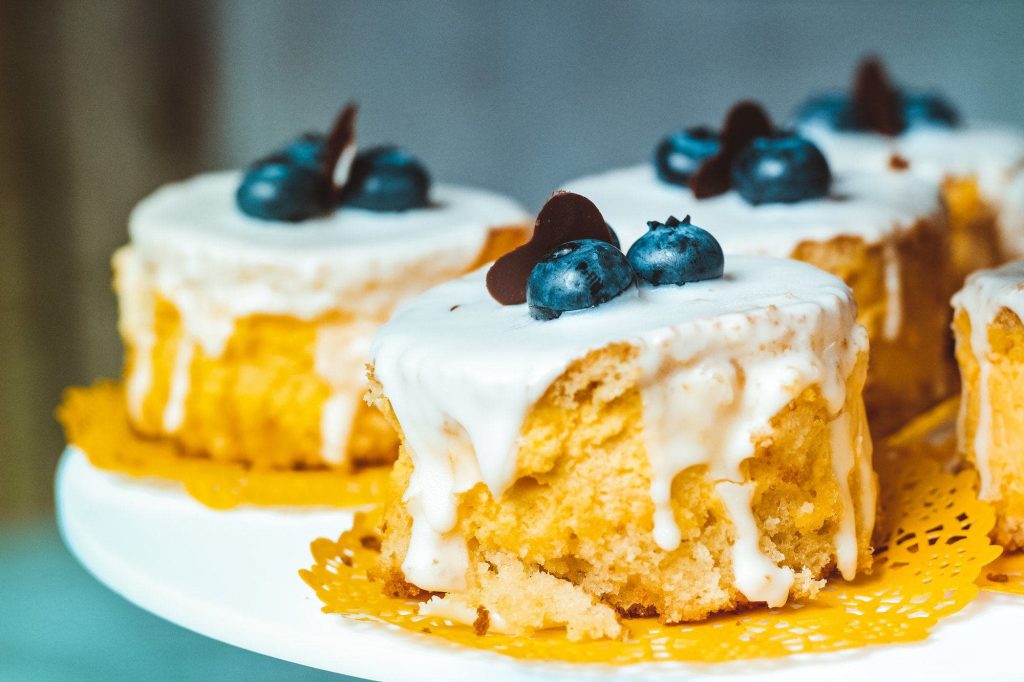
How To Bake Healthy But Tasty Cakes!
I’ve noticed lately, especially during this season when so many cookery programmes are on our screens, not least #GBBO that the children suddenly get an urge to get in the kitchen and start baking. Their way of baking is to take a standard recipe with ‘normal’ ingredients then switch out the less desirable ingredients in order to replace those with better, healthier alternatives. Often when you use healthier alternatives in recipes though, the flavour or texture may differ so it’s good to know a few tricks and tips to make sure that your healthier bake is a success.
FATS
- Fats are a necessary ingredient in cake making. Why?
- Fats keep your cake light (honest!) – if you take out the fat and instead use liquids (water, fruit juice etc) the cake becomes flat and chewy. It’s important to leave the fats in to help protect the protein in the flour. That’s why swapping in a low-fat ingredient changes the density.
- Fat traps bubbles of air – many baking recipes have you cream the fat and sugars together as the first step. There’s a good reason for that. As you cream these two ingredients together, you add air bubbles. These bubbles help make the item rise during baking.
- Fat improves the moistness of cakes – the fat doesn’t evaporate during cooking, nor is it absorbed by other ingredients, unlike liquids.
- Which fats to use?
- Ideal fats are those that are in a solid state at room temperature – butter and coconut oil therefore work really well. That way you can whip in lots of air bubbles at the start.
EGGS
- Having said what I have said about fats egg yolks can in fact be used in place of some of the fat in a cake. They have a binding property and can make cakes richer and denser.
- Egg whites can be whipped into a meringue and gently folded into a cake mixture towards the end before baking to give a light and fluffy texture.
- Eggs allow your cake to rise too. The proteins unwind and stretch to form a flexible, elastic film that encases air bubbles.
- Duck eggs are rich in protein and often tolerated better than chickens eggs. They tend to be larger than chickens eggs. They also lend themselves better to baking so if you can afford to use duck eggs it is worth it.
What if you cannot tolerate eggs? There are lots and lots of egg alternatives when baking. Replace 1 egg with:
2 heaped tbsp arrowroot powder
2 heaped tbsp potato starch powder
1 tbsp ground flaxseeds or chia seeds and 3 tbsp of water
3 tbsp fruit puree e.g. apple puree
1/2 mashed banana
1/4 cup silken tofu
1 tbsp gelatin and 3 tbsp lukewarm water
SUGARS
- Firstly when baking cakes I recommend reducing the sugar in the recipe you are using by 1/3rd. You should notice no discernible difference and you are doing everyone a favour.
- Secondly see if you can reduce the sugar even further by adding naturally sweet ingredients: Carrots, Beetroot, Apples, Pears, Berries, Bananas can all add sweetness, moistness and some added fibre to your bake.
- If you do want to use sugar then certain sugars provide advantages –
- Raw Honey You tend to have to buy this at source, from a health food store or online. It is very easy for our body to digest and it has a lower glycemic index than refined sugar. As it is quite sweet you don’t need to use as much. If a recipe calls for 200g sugar you could use 125g raw honey for example. Drop your oven temperature a little though and cook the cake for a little longer as honey can burn more easily than sugar.
- Blackstrap Molasses You can buy this from supermarkets or health food stores. It is not expensive. It provides a fantastically rich taste and tends to be best combined with a little unrefined sugar such as rapadura or coconut sugar (see below).
- Rapadura This is the most nutrient dense of the unrefined sugars that you can buy. It is difficult to get and you may need to buy online. It is worth it though. You can use this exactly as you would sugar but it has a lower glycemic index. It also has a lovely caramel flavor. I urge you to keep this sugar in your cupboard for healthy baking.
- Coconut Sugar is evaporated coconut nectar. It is another lower glycemic option when compared to sugar. A slightly milder taste than rapadura and more expensive but actually easier to get hold of in mainstream health food stores and even some supermarkets.
- Stevia The fantastic thing about stevia is that it has a glycemic index of 0. It is a very natural product because it comes from the leaves of the stevia plant. You only need about 1 teaspoon of stevia powder instead of a cup of sugar. That means less volume and that your cake may be slightly drier so also reduce the baking tin size and baking temp by 25 percent, add an additional egg white or slightly increase baking powder/soda, and add fruit puree or yogurt for moistness.
- Pure Maple Syrup is boiled down from the sap of the maple tree, and can be used the same way as honey. Always use real maple syrup — not maple flavoured. . Like honey maple syrup can burn so lower the temperature of your oven by 20 degrees and cook for longer if necessary.
FLOURS
- Opt for wholegrain flour instead of white. While this will give a denser texture, the health benefits will be far greater. Wholemeal flour will increase the fibre content and make your cake feel more filling. It also provides a lovely, slightly nutty, flavour.
- Opt for spelt, einkorn or kamut (collectively known as ‘ancient grains’) over wheat flour. These have been grown in a more traditional way (the way wheat used to be grown) and will be exposed to less herbicides and pesticides as a result. There is some evidence to suggest that the rise in wheat sensitivity is due to the use of chemicals used on wheat just before harvesting to increase yield. Ancient grains tend to have fewer calories than wheat and are higher in protein.
- If you want a gluten free cake try using naturally gluten free flours such as buckwheat, brown rice flour, gluten free oat flour or quinoa flour.
- Brown rice flour. This is especially good when combined with other flours, such as buckwheat. You can also make your own by processing brown rice to a powder in a good quality food processor.
- Buckwheat flour. Actually not a grain at all but it can be used in baking all the same. A very particular flavour and not to everyone’s taste so you can mix it with brown rice flour or use strong flavours within the cake. My two are fine with this as the only flour in cakes so long as I use bananas, dates or maple syrup to hide the buckwheat flavor!
- Gluten Free Oat flour. When used in recipes, a little more liquid needs to be added. Gluten free oats can be ground in a food processor to make this flour though too.
- If grain free and gluten free then use nut flours or coconut flour.
- Coconut flour. This type of flour is high in fibre, low in carbohydrates and a good source of protein. Recipes will need a lot more liquid when using coconut flour but will require less sugar because coconut has a natural sweetness to it. In baked goods, you generally want to substitute 1/4 cup to 1/3 cup coconut flour for 1 cup grain-based flour. You will also need to increase the number of eggs. In general for every one cup of coconut flour you use, you will need to use six beaten eggs in your recipe in addition to approximately one cup liquid such as coconut milk.
- Tapioca flour. This type of flour adds a sweetness and chewiness to baking. It can also be used a thickener.
- Almond flour. This type of flour is made from ground almonds. It can be used as a 1:1 substitute for wheat flour but you will need to add more eggs to help bind the flour together but less butter/coconut oil as nuts contain more fat than wheat.
- Banana Flour – This type of flour can replace any plain/wheat flour in a recipe too.
- Black beans – If you are making brownies, try using one cup of pureed black beans instead of one cup of flour. You won’t be able to taste the beans, and they give the brownies a delicious fudgy texture.
Happy Baking!
